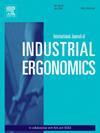The Magnetic Cursor pointing technique (MagCursor): A gaze-assisted manual pointing technique based on human eye-hand coordination patterns
IF 3
2区 工程技术
Q2 ENGINEERING, INDUSTRIAL
International Journal of Industrial Ergonomics
Pub Date : 2025-05-01
DOI:10.1016/j.ergon.2025.103760
引用次数: 0
Abstract
Gaze-assisted manual pointing techniques have demonstrated significant potential for achieving fast and accurate pointing and selection performance. However, several empirical studies have found negative effects when using these techniques, possibly due to the insufficient consideration of human eye-hand coordination patterns. Therefore, we proposed the Magnetic Cursor pointing technique (MagCursor), which achieves intuitive gaze pointing and incorporates an appropriate temporal threshold to mitigate potential conflicts between gaze control and manual control. Using two manual pointing devices (a trackball mouse and a touchpad), we compared MagCursor with a manual-only condition (Manual-Only), and with a commercial gaze-assisted manual pointing technique called Tobii-MAGIC. We found that MagCursor outperformed Manual-Only in terms of increased input speed or decreased workload, and outperformed Tobii-MAGIC in terms of increased input speed, accuracy and decreased workload. This work contributes to the design of gaze-assisted manual pointing techniques and may extend the application of these techniques to a wider range of contexts.
磁光标指向技术(MagCursor):一种基于人眼手眼协调模式的注视辅助手动指向技术
注视辅助的手动指向技术已经证明了实现快速和准确的指向和选择性能的显著潜力。然而,一些实证研究发现,当使用这些技术时,可能由于没有充分考虑人的手眼协调模式而产生负面影响。因此,我们提出了磁光标指向技术(MagCursor),该技术实现了直观的凝视指向,并结合了适当的时间阈值来缓解凝视控制与手动控制之间的潜在冲突。使用两种手动指向设备(轨迹球鼠标和触摸板),我们将MagCursor与纯手动状态(manual-only)以及称为Tobii-MAGIC的商业凝视辅助手动指向技术进行了比较。我们发现MagCursor在提高输入速度或减少工作量方面优于Manual-Only,而在提高输入速度、准确性和减少工作量方面优于Tobii-MAGIC。这项工作有助于设计凝视辅助的手动指向技术,并可能将这些技术的应用扩展到更广泛的环境中。
本文章由计算机程序翻译,如有差异,请以英文原文为准。
求助全文
约1分钟内获得全文
求助全文
来源期刊
CiteScore
6.40
自引率
12.90%
发文量
110
审稿时长
56 days
期刊介绍:
The journal publishes original contributions that add to our understanding of the role of humans in today systems and the interactions thereof with various system components. The journal typically covers the following areas: industrial and occupational ergonomics, design of systems, tools and equipment, human performance measurement and modeling, human productivity, humans in technologically complex systems, and safety. The focus of the articles includes basic theoretical advances, applications, case studies, new methodologies and procedures; and empirical studies.

 求助内容:
求助内容: 应助结果提醒方式:
应助结果提醒方式:


